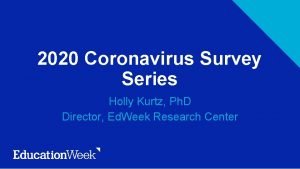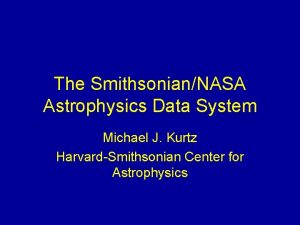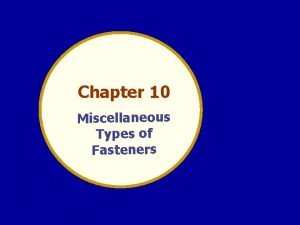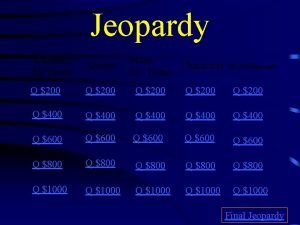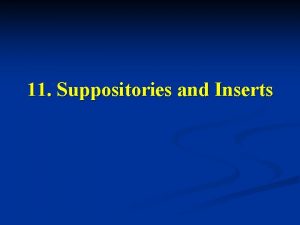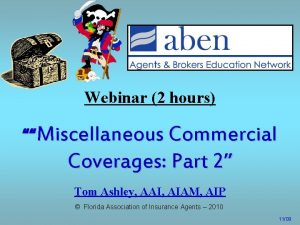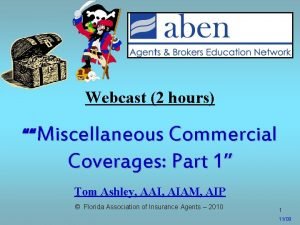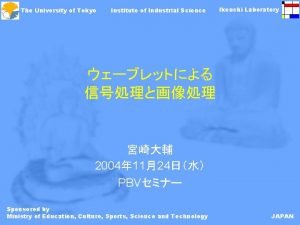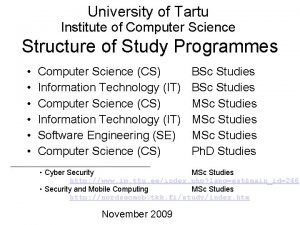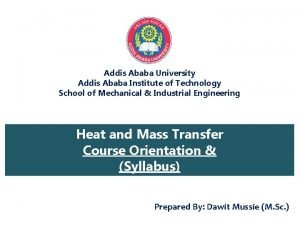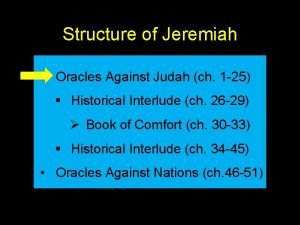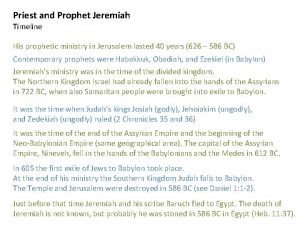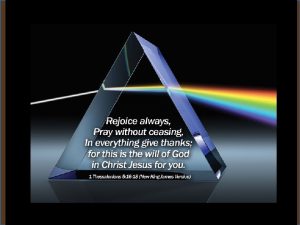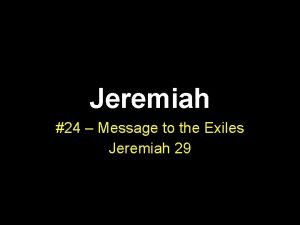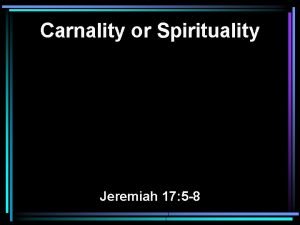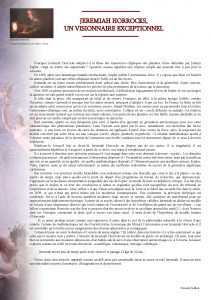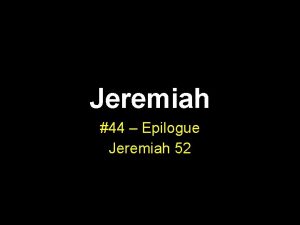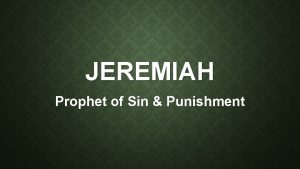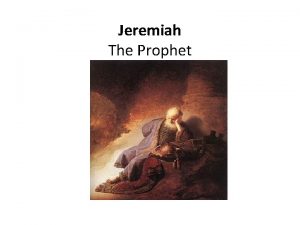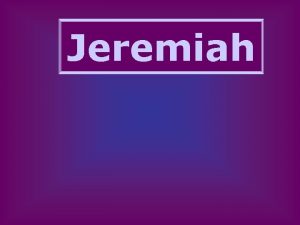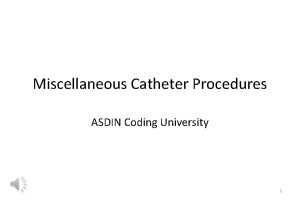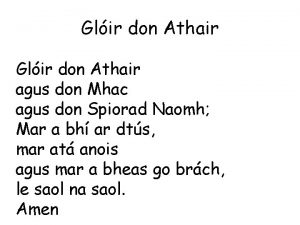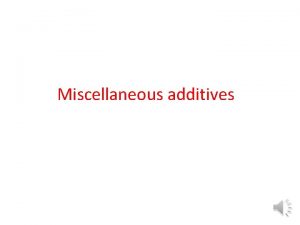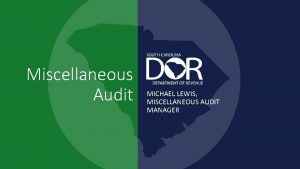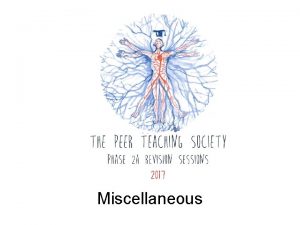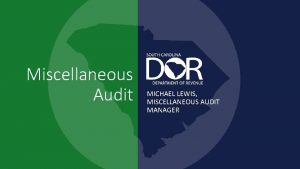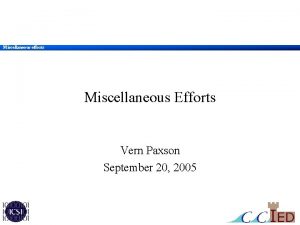Miscellaneous topics Don Kurtz Jeremiah Horrocks Institute University



















































- Slides: 51

Miscellaneous topics Don Kurtz Jeremiah Horrocks Institute University of Central Lancashire IAC WS 2010 – Lecture 4 2/26/2021

The first exoplanet n n The first exoplanet – PSR 1829 -10 b Using the timing method M = 10 Mearth Bailes et al. , 1991, Nature, 352, 311 P = 6 months; e =0 “It is not clear whether it formed in the aftermath of the supernova that created the neutron star, or was pre-exisiting and somehow survived through the late stages of stellar evolution …” IAC WS 2010 – Lecture 4 2/26/2021

The first exoplanet n n n The first exoplanet – PSR 1829 -10 b A “small correction” to the value of the Earth’s ellipticity Imprecise position of the pulsar Lyne & Bailes 1991, Nature, 355, 213 n n Error in the calculation of BJD led to the discovery of a planet with P = 6 months The planet’s name is Earth IAC WS 2010 – Lecture 4 2/26/2021

Time and time traps n n What is time? Measuring time n Calendar adjustments n Leap years n Leap seconds n Length of the Day is increasing by ~1. 7 ms/century; n i. e. the Earth’s rotation is accelerating on a long time scale n At the moment it is decreasing IAC WS 2010 – Lecture 4 2/26/2021

Universal Time (UT) n n UT is based on the Earth’s rotation UT 1 is based on a mean solar day of 86400 mean solar seconds In practice, UT 1 is based on GMST Ps ≈ 86164. 0905 mean solar seconds n n This is 0. 0084 s shorter than the rotation period bec ause of precession The mean solar day is about 1 ms longer than 86400 s Earth’s rotation period is currently 86164. 0999 SI s UT 1 is measured with VLBI of quasars n (GPS is not good enough because of orbital variations) IAC WS 2010 – Lecture 4 2/26/2021

Ephemeris Time (ET) n n n ET is based on the period of the Earth’s orbit about the Sun It is based on Newcomb’s Tables of the Sun (1895) The length of the tropical ET year in 1900 was 31, 556, 925. 9747 s The reciprocal of this defines the ET second 1976 n Terrestrial dynamical time (TDT) n Barycentric dynamical time (TDB) 1991 IAU renames TDT Terrestrial Time (TT) IAC WS 2010 – Lecture 4 2/26/2021

TT n n n TT = TAI + 32. 184 s n TAI = International Atomic Time n The offset is the difference between ET and UT 1 on 1 January 1958 1991 IAU n Basis of the time scale includes GR n Geocentric coordinate time (TCG) n Barycentric coordinate time (TCB) These do not run at the same rate as TT! IAC WS 2010 – Lecture 4 2/26/2021

TAI n n n This is defined by a hyperfine transition in the ground state of Ce 133 The atomic second is defined to be 9, 192, 631, 770 periods of the radiation of this transition Two hundred clocks in 50 countries contribute to the maintenace of TAI IAC WS 2010 – Lecture 4 2/26/2021

Does this matter? IAC WS 2010 – Lecture 4 2/26/2021

Earth rotation IAC WS 2010 – Lecture 4 http: //tycho. usno. navy. mil/systime. html 2/26/2021

UTC n n Coordinated UT was introduced in the 1950 s n Adjustment to quartz clocks were coordinated between laboratories in the USA and UK n It is now international Both rate and epoch are variable to stay in step with astronomical time IAC WS 2010 – Lecture 4 2/26/2021

UTC Mc. Carthy, D. , 2004, In Transits of Venus: New Views of the Solar System and Galaxy, D. W. Kurtz, ed. , IAU C 196, Cambridge University Press IAC WS 2010 – Lecture 4 2/26/2021

Julian Date n n Joseph Justus Scaliger introduced Julian Date in 1583 at the time of the Gregorian Calendar reform The zero point is 4713 BCE January 1 at 12: 00 at the meridian of Alexandria n Solar cycle of 28 years n Metonic cycle of 19 years (235 lunar months = 18. 9999 years) n Roman indiction (tax) cycle of 15 years! 15 x 28 x 19 = 7980 years The epoch is the last time they were all in their first year IAC WS 2010 – Lecture 4 2/26/2021

Julian Date n n n 12: 00 UT 2010 November 26 = n JD 245 5527. 00000 Modified Julian Date MJD = JD – 240 0000. 5 (Watch out!) n JD 245 5527. 00000 = MJD 55526. 50000 Reduced Julian Date RJD = JD – 240 0000. 0 n JD 245 5527. 00000 = RJD 55527. 00000 Truncated Julian Date n TJD = JD – 244 0000. 5 (NASA definition) n TJD = (JD – 0. 5) mod 10, 000 (NIST) n TJD = JD – 244 0000. 0 (common asteroseismic use) IAC WS 2010 – Lecture 4 2/26/2021

HJD, BJED n HJD = Heliocentric Julian Date n n BJD = Barycentric Julian Date n n Correct the time of observation to the centre of the Sun Correct the time of observation to the barycentre of the Solar System Differs from HJD by up to ~ 2 s Jupiter is the prime cause of this, but even the asteroids are measurable BJED = Barycentric Julian Ephemeric date n n BJD with the leap seconds removed Note that the IAU recommends that JD be given in ET, but asteroseismology uses UTC IAC WS 2010 – Lecture 4 2/26/2021

Kepler Time n n The Kepler team originally gave times in MJD measured here at the Earth The latest download files at KASOC give BJD corrected from the time of observation at the satellite (not Earth, so not so easy to do using standard tools) Many Kepler papers use BJD – 240 0000. 0, or BJD - 245 0000. 0 and call these truncated BJD. Be clear and be careful IAC WS 2010 – Lecture 4 2/26/2021

Beware of time traps! n n n The potential for mistakes is high Make sure you are sure of your time base(s), especially when concatenating data sets from different sources If you do discover a planet, it is better that it is not the Earth IAC WS 2010 – Lecture 4 2/26/2021

Computer truncation n n n BJD 245123456 BJD 5123456 as in Kepler data 11 decimal precision; 1012 ~ 240, so 40 bits Exponent up to 999, so 10 bits Sign (+ or -) on exponent and on mantissa gives 2 more bits You need 52 bits to represent this time 32 -bit precision is not enough; you need 64 -bit precision for your computations IAC WS 2010 – Lecture 4 2/26/2021

The timing method n n Bailes & Lyne were wrong about the first pulsar planet But the first exoplanets were discovered orbiting a pulsar using the timing method n PSR 1257+12; 6. 2 -ms pulsar Wolszczan & Frail 1992, Nature, 355, 145 n n O-C = Observed – computed V 391 b Pegasi sd. BV EHB stars Silvotti et al. 2007, Nature, 449, 189 M = 3. 2 Mjupiter a = 1. 7 au; P = 1170 d IAC WS 2010 – Lecture 4 2/26/2021

V 391 b Peg ν 1 IAC WS 2010 – Lecture 4 2/26/2021

V 391 b Peg ν 2 IAC WS 2010 – Lecture 4 2/26/2021

The timing method n n n Pulsating stars can be good clocks A planet induces a Doppler shift to the star’s pulsation frequency The pulsation frequency is then periodically variable with time Be on the lookout for pulsational frequency multiplets split by the orbital frequency of the planet The splitting depends on frequency, so you cannot sum over all pulsation frequencies IAC WS 2010 – Lecture 4 2/26/2021

Discovering clocks in the telescope n n n When searching for periodic phenomena in astronomy, be careful not to discover the clocks in your telescope The “pulsar” at the core of the SN 1987 a remnant Pulsation harmonics in the ro. Ap stars HD 60435 and HR 1217 IAC WS 2010 – Lecture 4 2/26/2021

SN 1987 a n n n SN 1987 a (February 1987) in the LMC was the first naked -eye supernove since Kepler’s supernova of 1604 A team searched hard for a pulsar remnant Using the CTIO 4 -m telescope they found one in January 1989 n n n ν = 1968. 629 Hz P ~ 0. 5 ms! Kristian et al. 1989, Nature, 338, 324 Theory argued for spin-up from material falling back onto the remnant Woosley & Chevalier 1989, Nature, 338, 321 n Uh-oh! Nobody could confirm the observation IAC WS 2010 – Lecture 4 Kristian et al. 1991, Nature, 349, 747 2/26/2021

Harmonics in ro. Ap stars – HR 3831 Artefact; P = 2 sidereal min ν = 8. 4 m. Hz Real – 2 v, 3 v, 4ν IAC WS 2010 – Lecture 4 Kurtz et al. 1993, MNRAS, 260, 343 2/26/2021

Harmonics in ro. Ap stars – HD 60435 Artefact; P = 4 sidereal min ν = 4. 2 m. Hz Real IAC WS 2010 – Lecture 4 Matthews et al. 1986, Ap. J, 300, 348 2/26/2021

Harmonics in ro. Ap stars – HR 1217 White, T. et al. 2010, in preparation IAC WS 2010 – Lecture 4 2/26/2021

Aliases – a visual view n Aliases from gaps in the data n Nyquist aliases n How to create a spectral window n Be careful of asymetry near ν = 0 IAC WS 2010 – Lecture 4 2/26/2021

The amplitude spectrum of HR 1217 WET 2002 29 February 2021

Amplitude spectrum – the Spectral Window WET 2002 30 February 2021

The Spectral Window near ν = 0 WET 2002 31 February 2021

The Spectral Window near ν = 0 WET 2002 32 February 2021

Amplitude spectrum – ν 1 WET 2002 33 February 2021

Amplitude spectrum – ν 2 WET 2002 34 February 2021

Amplitude spectrum – ν 3 WET 2002 35 February 2021

Amplitude spectrum – ν 4 WET 2002 36 February 2021

Aliases – a visual view n n Aliases from gaps in the data So fine, but who cares? Kepler data have almost no gaps, so there is no problem, right? Maybe … IAC WS 2010 – Lecture 4 2/26/2021

Co. Ro. T - HD 50844 - δ Sct star IAC WS 2010 – Lecture 4 2/26/2021

How to grow your own grass Pieter de Groote Ph. D thesis IAC WS 2010 – Lecture 4 2/26/2021

Nyquist Aliases – a visual view n n n Why is the Nyquist frequency half the sampling frequency? Can you find frequencies above the Nyquist frequency? cadence = 1 minute Sampling frequency = 16. 666 m. Hz = fs Nyquist frequency = 8. 333333 m. Hz IAC WS 2010 – Lecture 4 2/26/2021

Input frequency fi = 0. 1 m. Hz Input frequency fs – f i IAC WS 2010 – Lecture 4 fs + f i 2 fs – fi 2 fs + fi 2/26/2021

Input frequency fi = 1. 0 m. Hz Input frequency fs – f i IAC WS 2010 – Lecture 4 fs + f i 2 fs – fi 2 fs + fi 2/26/2021

Input frequency fi = 5. 0 m. Hz Input frequency fs – f i 2 fs + fi fs + f i 2 fs – fi IAC WS 2010 – Lecture 4 2/26/2021

Input frequency fi = 11. 66666 m. Hz fs – f i IAC WS 2010 – Lecture 4 Input frequency 2/26/2021

Nyquist Aliases – a visual view n n You must have some external constraint to choose the correct Nyquist alias This does not matter whether it is above or below the Nyquist frequency You can detect frequencies above the Nyquist frequency If you do, it is better to get higher cadence data (if you can) IAC WS 2010 – Lecture 4 2/26/2021

Pulsation phases n n n Phases are sometimes useful t 0 matters! f and Φ are coupled When frequency is fitted by nonlinear least squares t 0 should be set to the central time of the data set Otherwise the phase errors are overestimate at best, and at worst there is no convergence IAC WS 2010 – Lecture 4 2/26/2021

KIC blah IAC WS 2010 – Lecture 3 2/26/2021

KIC blah IAC WS 2010 – Lecture 3 2/26/2021

KIC blah IAC WS 2010 – Lecture 3 2/26/2021

KIC 8677585 – ro. Ap star g mode or background binary star? IAC WS 2010 – Lecture 3 Balona et al. 2010, MNRAS, in press 2/26/2021

Kepler data Forget computer games – go prospecting! IAC WS 2010 – Lecture 3 2/26/2021
 Jeremiah horrocks institute
Jeremiah horrocks institute Horrocks apparatus calculation
Horrocks apparatus calculation Difference between concurrent and terminal disinfection
Difference between concurrent and terminal disinfection Dylan horrocks hicksville
Dylan horrocks hicksville Simon horrocks
Simon horrocks Judy kurtz
Judy kurtz Jessie kurtz
Jessie kurtz Alicia kurtz
Alicia kurtz Ron kurtz hakomi eine körperorientierte psychotherapie
Ron kurtz hakomi eine körperorientierte psychotherapie Holly kurtz
Holly kurtz Paul michael kurtz
Paul michael kurtz Definisi pemasaran online
Definisi pemasaran online Without asking take something that does not belong to you
Without asking take something that does not belong to you Suppositories meaning
Suppositories meaning Miscellaneous details
Miscellaneous details 10 different types of fasteners
10 different types of fasteners Hinge tool classification
Hinge tool classification Miscellaneous operators in javascript
Miscellaneous operators in javascript Pencil shaped suppository
Pencil shaped suppository Justice wargrave quotes
Justice wargrave quotes Electronic cookware miscellaneous
Electronic cookware miscellaneous Nanoxynol
Nanoxynol Miscellaneous commercial insurance
Miscellaneous commercial insurance Miscellaneous commercial insurance
Miscellaneous commercial insurance Persuasive business letter format
Persuasive business letter format Fatty acid composed of
Fatty acid composed of Essential parts of stock
Essential parts of stock Institute of industrial science the university of tokyo
Institute of industrial science the university of tokyo Confucius institute at moscow state linguistic university
Confucius institute at moscow state linguistic university Lviv polytechnic university
Lviv polytechnic university Eli gmu
Eli gmu King abdulaziz university english language institute
King abdulaziz university english language institute Aled jones anglia ruskin
Aled jones anglia ruskin University of tartu institute of computer science
University of tartu institute of computer science Kharkiv polytechnic institute
Kharkiv polytechnic institute Francisco de asis university institute
Francisco de asis university institute Addis ababa university institute of technology
Addis ababa university institute of technology Leonardo sarao picture
Leonardo sarao picture Leonard herman intermediate school
Leonard herman intermediate school Jeremiah 18
Jeremiah 18 What are the ancient paths in jeremiah 6:16
What are the ancient paths in jeremiah 6:16 Jereboa
Jereboa Jeremiah 12 5
Jeremiah 12 5 Jeremiah and ezekiel timeline
Jeremiah and ezekiel timeline Pastor jeremiah steepek
Pastor jeremiah steepek Jeremiah 29 nasb
Jeremiah 29 nasb Jeremiah 9
Jeremiah 9 Jeremiah 16 nkjv
Jeremiah 16 nkjv Jeremiah 30-33
Jeremiah 30-33 Jeremiah 24
Jeremiah 24 Jeremiah 29:13-14 images
Jeremiah 29:13-14 images Jer 17 5-8
Jer 17 5-8









